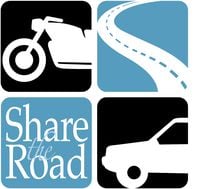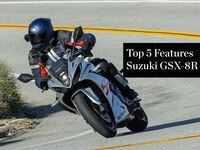According to the most recent statistics compiled by the National Highway Traffic Safety Administration (NHTSA), fatal accidents between cars and motorcycles are on the rise, and helmet usage is on the decline. With warm riding weather approaching, May is the perfect month to make drivers and riders aware of these alarming statistics to promote Motorcycle Safety Awareness. In an effort to make drivers more aware of motorcyclists, the NHTSA's "Share the Road" campaign emphasizes the following points and encourages all riders to share this information with non-riding friends who drive:
Stop the texting! Road users should never drive while distracted. Doing so can result in tragic consequences for everyone, including motorcyclists.
A motorcyclist has the same rights, privileges, and responsibilities as any other motorist on the roadway.
Allow a motorcyclist a full lane width. Though it may seem as if there is enough room in a single lane for a motor vehicle and a motorcycle, looks can be deceiving. Do not share the lane: a motorcyclist needs room to maneuver safely.
Because motorcycles are smaller than most vehicles, they can be difficult to see. Their size can also cause other drivers to misjudge their speed and distance.
Size also counts against motorcycles when it comes to blind spots. Motorcyclists can be easily hidden in a vehicle's blind spot. Always look for motorcycles by checking your mirrors and blind spots before switching to another lane of traffic.
Drivers should always signal your intentions before changing lanes or merging with traffic. This allows motorcyclists to anticipate your movement and find a safe lane position.
Don't be fooled by a flashing turn signal on a motorcycle—it may not be self-canceling and the motorcyclist may have forgotten to turn it off. Wait to be sure the rider is going to turn before you proceed.
Allow more distance – three or four seconds – when following a motorcycle; this gives the motorcycle rider more time to maneuver or stop in an emergency. Motorcycle riders may suddenly need to change speed or adjust lane position to avoid hazards such as potholes, gravel, wet or slippery surfaces, pavement seams, railroad crossings, and grooved pavement.

/cloudfront-us-east-1.images.arcpublishing.com/octane/7OWQWAWJBFCGTAYQWBMWGNMNB4.jpg)
/cloudfront-us-east-1.images.arcpublishing.com/octane/4G5XKCDIHRCGRHVF7OPORG7ZX4.jpg)
/cloudfront-us-east-1.images.arcpublishing.com/octane/D2BDYKKNZ5GRHGDMI4PZTGRMME.jpg)

/cloudfront-us-east-1.images.arcpublishing.com/octane/UAY4WSZPOFDQRP4MCEXAKDFQOQ.jpg)

/cloudfront-us-east-1.images.arcpublishing.com/octane/X5CE3KSJHZHM5CUFGPZ7U26WB4.jpg)
/cloudfront-us-east-1.images.arcpublishing.com/octane/COWLTPGFAFGDDGJCTENYMA4VJM.jpg)
/cloudfront-us-east-1.images.arcpublishing.com/octane/H3PKUGPSUJFTND4RFPSI4OIDCE.jpg)
/cloudfront-us-east-1.images.arcpublishing.com/octane/UHGQA3MQDFCA3HLBWF7S76WH6Y.jpg)
/cloudfront-us-east-1.images.arcpublishing.com/octane/Q5EORCSTNFAVBJC4IYUHIKJTXQ.jpg)
/cloudfront-us-east-1.images.arcpublishing.com/octane/XIJ5FUFSP5A3NL7MOVZGJXAHC4.jpg)
/cloudfront-us-east-1.images.arcpublishing.com/octane/V5NZN3CGS5B5PPYFYJHIPAU5S4.jpg)
/cloudfront-us-east-1.images.arcpublishing.com/octane/CZE6ONOBU5E7HPIEEADU376C4M.jpg)
/cloudfront-us-east-1.images.arcpublishing.com/octane/UT4KL3SIYJBSPNHWJXTBE6MTGE.jpg)
/cloudfront-us-east-1.images.arcpublishing.com/octane/Q3UOIDZ22ZEVDBZUWGJXIMGJKI.jpg)
/cloudfront-us-east-1.images.arcpublishing.com/octane/YQM66WXZV5AAXNNOIUVOGVXZMY.jpg)
/cloudfront-us-east-1.images.arcpublishing.com/octane/J47NFTXNLFFGHELHZCUD2LCITA.jpg)
/cloudfront-us-east-1.images.arcpublishing.com/octane/NXPQBTLX3NCILKQ2GCFJYNIDEM.jpg)
/cloudfront-us-east-1.images.arcpublishing.com/octane/6U7NJLAYMRBZTIGNKWIA5OK2FQ.jpg)
/cloudfront-us-east-1.images.arcpublishing.com/octane/IYTZQWUROVC25IMTDEWUDQ5IQE.jpg)
/cloudfront-us-east-1.images.arcpublishing.com/octane/YJODDXEL2ZB5TENKPPN4BEYJAE.jpg)
/cloudfront-us-east-1.images.arcpublishing.com/octane/QEQQUZYNJFAIJB4DZFVFSNTCQ4.jpg)
/cloudfront-us-east-1.images.arcpublishing.com/octane/F4EEHDT3UZFKPLKVGDWMMPFEQE.jpg)